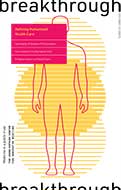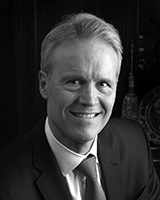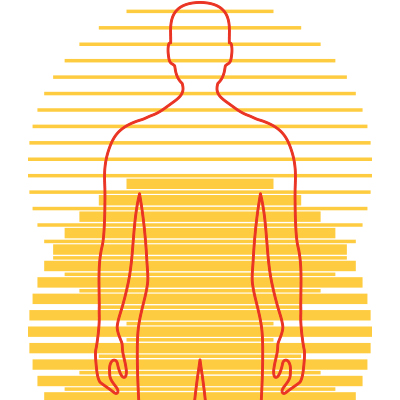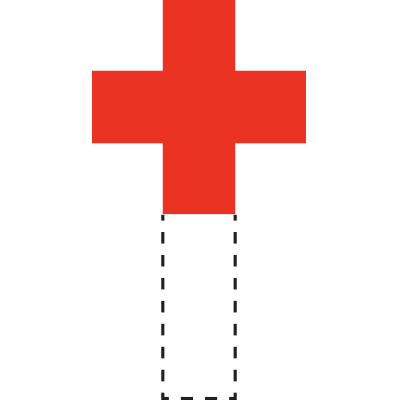

David B. Hellmann,
MD, MACP
The Center for Innovative Medicine was founded with a critical mission: to make medicine a better public trust.
Just what does it mean to be a public trust? I think renowned physician and public health expert Steven Schroeder may have said it best in his seminal 1989 paper: “Medicine is entrusted by society to improve the health of the public through education, patient care and research. In return, medicine receives significant public funding, respect and autonomy.”
Today, we are living through an extraordinary season in our nation, with so much at stake in federal funding for biomedical research. It’s critical that we re-commit to this core principle of making medicine a better public trust, and that we share our efforts with everyone who will listen — notably our elected leaders and citizenry. As physician-scientists, I’m convinced we could all do a better job of communicating our work and its life-saving impact to the public, and of offering gratitude for the taxpayer funding and philanthropic support that makes that work possible.
Both efforts — communicating and saying “thanks!” — have always been key to CIM’s Breakthrough magazine and this issue is no exception. You’ll find compelling articles that describe ways CIM-funded faculty and staff are humanizing medicine — through impact grants that improve patient care (p. 12), research aimed at quantifying humanized health care (p. 2) and advocacy to equip physicians to be better listeners (p. 8). The throughline of every article in the issue? This life-changing work wouldn’t be possible without the generous support of CIM’s donors.
And wait — there’s more! The extraordinary generosity of our donors has now made it possible for CIM to launch an ambitious new funding initiative through the Department of Medicine. Over the next year, thanks to significant funding from CIM donors, the Department of Medicine will be offering 12 “CIM/Next Generation Scholar Awards” to support the success of outstanding early-career faculty who are innovators in research, education and clinical care. Each CIM/Next Generation Scholar will be eligible to receive up to $240,000 of funding over three years.
This funding comes at a critical time and meets an urgent need. To all of our donors: Thank you. Our gratitude knows no bounds.

David B. Hellmann, M.D., M.A.C.P.
Aliki Perroti Professor of Medicine
Don Willett May 21st, 2025
Posted In:

David B. Hellmann,
MD, MACP
The Center for Innovative Medicine was founded with a critical mission: to make medicine a better public trust.
Just what does it mean to be a public trust? I think renowned physician and public health expert Steven Schroeder may have said it best in his seminal 1989 paper: “Medicine is entrusted by society to improve the health of the public through education, patient care and research. In return, medicine receives significant public funding, respect and autonomy.”
Today, we are living through an extraordinary season in our nation, with so much at stake in federal funding for biomedical research. It’s critical that we re-commit to this core principle of making medicine a better public trust, and that we share our efforts with everyone who will listen — notably our elected leaders and citizenry. As physician-scientists, I’m convinced we could all do a better job of communicating our work and its life-saving impact to the public, and of offering gratitude for the taxpayer funding and philanthropic support that makes that work possible.
Both efforts — communicating and saying “thanks!” — have always been key to CIM’s Breakthrough magazine and this issue is no exception. You’ll find compelling articles that describe ways CIM-funded faculty and staff are humanizing medicine — through impact grants that improve patient care (p. 12), research aimed at quantifying humanized health care (p. 2) and advocacy to equip physicians to be better listeners (p. 8). The throughline of every article in the issue? This life-changing work wouldn’t be possible without the generous support of CIM’s donors.
And wait — there’s more! The extraordinary generosity of our donors has now made it possible for CIM to launch an ambitious new funding initiative through the Department of Medicine. Over the next year, thanks to significant funding from CIM donors, the Department of Medicine will be offering 12 “CIM/Next Generation Scholar Awards” to support the success of outstanding early-career faculty who are innovators in research, education and clinical care. Each CIM/Next Generation Scholar will be eligible to receive up to $240,000 of funding over three years.
This funding comes at a critical time and meets an urgent need. To all of our donors: Thank you. Our gratitude knows no bounds.

David B. Hellmann, M.D., M.A.C.P.
Aliki Perroti Professor of Medicine
Don Willett May 21st, 2025
Posted In:
 Leaders of CIM’s Center for Humanizing Medicine (CHM) are on an ambitious mission: to create nothing less than a national model for humanized health care.
Leaders of CIM’s Center for Humanizing Medicine (CHM) are on an ambitious mission: to create nothing less than a national model for humanized health care.
Key to that effort? Systematically defining what it means for health care to be humanizing in order to guide improvements — at Johns Hopkins and across the nation — to ensure that every patient is treated with dignity and respect, and receives compassionate care.
“Apart from articles on hospital design, health care literature rarely mentions how it can be more ‘humanizing.’ This presents an opportunity to define a term that reframes our thinking and makes new solutions imaginable,” notes Scott Wright, co-director of the CHM and co-author of a new study that has done just that.
The bold quest to define — and create objective measures for — a previously uncharted aspect of health care is not new for Wright, who is the Anne Gaines and G. Thomas Miller Professor of Medicine.
In 2008, Wright was among a quartet of CIM scholars (supported in their work by Sarah Miller Coulson) who developed rigorous measures for clinical excellence in a landmark paper that appeared in Mayo Clinic Proceedings. Their work formed the basis for CIM’s Miller Coulson Academy of Clinical Excellence — which now includes more than 100 Johns Hopkins faculty members — and has set the standards for great doctoring at hospitals around the country.
With this new research effort, Wright and his collaborators have built a big tent, bringing together perspectives from a broad variety of players: patients and caregivers; physicians and nurses; health care researchers, administrators, educators and learners; and health care policymakers and finance experts.
Taking a broadly inclusive, holistic approach to defining humanized care is crucial, notes study co-author Sean Tackett, international medical education director for the Division of General Internal Medicine at Johns Hopkins Bayview Medical Center.
“Right now, measurement efforts are so fragmented,” says Tackett. Physician groups look at quality metrics on heart failure or pneumonia, for example, while the Office of Well-Being focuses on burnout among health care providers. Other hospital leaders examine employee engagement, and still others concentrate on patient satisfaction.
“All of these measures should be connected, and for our study we conceptualized them as being connected,” says Tackett. “Our goal is to integrate all of these different measures rather than have them compete with each other. That way we can arrive at solutions that are better for everyone.”
To do that, the research team turned to a tool known as “group concept mapping” to brainstorm and gather ideas from 63 individuals at five hospitals across the Johns Hopkins health care system. Nearly all who participated wore multiple hats in providing their perspectives (physician/educator/caregiver, for example, or nurse/patient/administrator). Most respondents, some 63%, indicated they could represent the patient perspective.
“Both Sean and I have worked before with group concept mapping, and it’s very effective for bringing together perspectives from a wide variety of people,” says Wright, the CHM’s Mary Gallo CIM Scholar. “In defining humanized health care, it’s so important to hear different voices.”
“In defining humanized health care, it’s so important to hear different voices.” – Scott Wright
All the participants were surveyed to respond to the prompt, “One thing that can be done to more fully humanize health care experiences is…” and then were given the opportunity to provide up to 20 ideas. Once all the responses were in, the research team reviewed them for consistency, then recruited small groups of participants to sort the ideas into piles based on concept similarity.
Finally, the researchers used a software program to create a “concept map” that features eight domains — pillars central to defining the critical elements of humanized health care.
“One of the things that came through loud and clear was the importance of clinicians giving time and attention to patients and making authentic connections with them,” says Tackett. Domain 1 includes elements such as listening without judgment or interruption, remaining present and undistracted, and attending to patients’ feelings and beliefs.
Wright notes that the concept map from the study, slated to appear in Mayo Clinic Proceedings, “can have immediate application to health care quality improvement and research.”
“At the Center for Humanizing Medicine, we are already applying this framework,” says Wright. “We are identifying relevant existing measures that are currently being collected and analyzed in silos at Johns Hopkins Medicine and we are looking for opportunities to integrate them and to determine what is not being measured.”
Don Willett May 21st, 2025
Posted In:

Physician and philosopher Daniel Sulmasy, who completed his residency training and postdoctoral fellowship at Johns Hopkins, lived for nearly 27 years as a Franciscan friar. Over the course of his impactful career, Sulmasy has devoted much of his energy to writing about problems in medical ethics, specifically exploring the connections between spirituality and medicine.
Last spring, he authored a perspectives essay that appeared in The New England Journal of Medicine that resonated with many at CIM — particularly cardiologist Roy Ziegelstein, who coined the term “personomics” in a widely cited editorial in the Journal of the American Medical Association a decade ago. The premise of personomics: In the rush to embrace the high-tech advances of precision medicine, too many doctors can lose sight of the individual patient’s unique life experiences.
“Dr. Sulmasy has written a masterful article about a very important aspect of personomics, describing how a patient’s spiritual and religious beliefs, practices and community are critical elements of the ‘personome’ that health care providers must understand and appreciate to take optimal care of the patient,” says Ziegelstein, vice dean for education and the Sarah Miller Coulson and Frank L. Coulson, Jr. Professor of Medicine.
“As originally described, personomics includes the psychological, social, cultural, behavioral and economic factors that influence health and disease,” continues Ziegelstein. “With respect to spirituality, I might have previously said, ‘It’s in there!’ as in the Prego spaghetti sauce commercial from 40 years ago. However, this article brilliantly highlights why spirituality should be considered a distinct domain of uniqueness — as stated in the article — ‘for people of all religions and of no religion.’”
Sulmasy is currently the inaugural André Hellegers Professor of Biomedical Ethics and director of the Kennedy Institute of Ethics at Georgetown University, with co-appointments in the Departments of Philosophy and Medicine. In December, he expanded upon insights from his article for a rapt group of attendees of a Johns Hopkins CIM Seminar. Among his central points:
Physicians play a key role in spiritual care. By inquiring about patients’ spiritual needs, they demonstrate respect for them as whole persons and strengthen the patient–physician relationship.
Doctors may be the only team members who uncover spiritual struggles or negative forms of coping that can interfere with a patient’s well-being, notes Sulmasy. He suggests following a “FICA” framework. This involves inquiring about the patient’s faith and spiritual beliefs; the importance of religion and spirituality in their lives; whether they belong to a spiritual community that could serve as a resource for them; and how patients would like to see spirituality addressed in relation to their medical care.
“It’s useful to make such assessments part of the routine social history, so that this knowledge can later be applied in patient care,” he writes.
Inquiry and engagement with the patient should be tailored to the specifics of the case: the seriousness of the medical condition, the setting, the patient’s level of distress, and their openness to spiritual conversation.
For patients with serious illness, physicians can start by asking about spiritual or religious beliefs and then broaden with more spiritual questions: “What are your deepest hopes? What sense, if any, can you make of this?” Following the patient’s lead, the questions can become more specific: “Are you at peace? Do you realize you are still valued and cherished, no matter how sick you are?” If the conversation becomes too complex, Sulmasy counsels doctors to step back and ask if a chaplain could stop by to continue the conversation.
Physicians may believe that if they don’t share the patient’s faith, they shouldn’t ask about spirituality or religion lest they make a mistake, offend the patient or seem disingenuous. But the deepest spiritual questions are applicable not only across all faiths but also to people who practice no religion.
“Buddhists and Christians, for instance, respond differently to human suffering,” he writes, “but the suffering that accompanies illness or injury is a universal aspect of the human predicament.”
Don Willett May 21st, 2025
Posted In:

In his Johns Hopkins lab, cell biologist Hiromi Sesaki focuses on the biology of the “mighty mitochondria,” the powerhouse of the cell that turns energy from food into the energy that the cell can use. He’s found that the behavior of the membrane-bound organelle plays an important role in the aging process of our cells — which is vital to his investigations within the CIM-supported Human Aging Project as the 2022 Karen and Ethan Leder CIM Human Aging Project (HAP) Scholar.
Most recently, Sesaki and colleague Miho Iijima, a fellow Johns Hopkins cell biologist, published an influential paper in the journal Nature that showed how a group of proteins linked to Parkinson’s disease and amyotrophic lateral sclerosis (ALS) act as “guardians” of mitochondria. Sesaki says, “These findings should advance our understanding of the development of Parkinson’s disease” — insights that could be key to improving life for the 1 million people in the United States who live with this neurodegenerative condition, which increases in incidence with age. Among the takeaways of the scientists’ study:
Size Matters
Mitochondria must be neither too big nor too small to work well, Sesaki notes, adding that scientists have long known that when mitochondria are stressed too much or are damaged beyond repair, they stop fusing, become smaller and degrade. With damaged mitochondria, cells are not as well-equipped to make energy. In the brain, stressed cells can cause neurodegeneration and neuroinflammation.
Proteins are Key
One way cells respond to mitochondria size-control issues caused by stress or damage is by turning on the activities of several proteins. Two of the proteins, called Parkin and PINK1, hang around the mitochondria’s membrane and work as a pair to enable the mitochondria to fuse or degrade. Abnormalities in the genes for Parkin and PINK1 are associated with the onset of Parkinson’s disease in humans. Another protein linked to ALS, OMA1, is also known to stop mitochondria from fusing upon stress.
A Double Knockout is Damaging
Previous studies have shown in mouse studies that when conditions in cells are normal, removing, or “knocking out,” any one of the genes that encode the Parkin, PINK1 and OMA1 proteins causes no abnormalities in mice or their mitochondria. Sesaki and Iijima wondered: What happens when two of the proteins are knocked out? By knocking out PINK1 and OMA1, the duo found that the double-knockout mice were small and had movement problems, along with excessively fused, oversized mitochondria in their neurons when compared to mice with normal versions of the genes. However, if only one gene is knocked out, the other genes still regulate mitochondrial fusion and mice show no signs of mitochondrial enlargement or dysfunction.
Fusion is “Double-Locked”
Based on their studies of genetically engineered mice with 18 variations of normal and knockout combinations of the three genes, along with others, Sesaki and Iijima now believe that mitochondrial fusion is “double-locked.” That’s because mitochondria have two membranes, so that turning off only one of the genes may disable one membrane but not both, and mitochondria can still fuse and remain somewhat healthy. “Working in tandem, Parkin-PINK1 and OMA1 act as guardians of mitochondria, ensuring that the organelles maintain their normal size and function,” Iijima notes.
Leaks Lead to Inflammation
The scientists also measured mitochondria’s main product — energy in the form of adenosine triphosphate (ATP) — and found no change, suggesting that mitochondrial energy production is not affected. They discovered that when mitochondria got too big, their mitochondrial DNA leaked out into the cytosol, the fluid that fills up the space inside cells. This triggered an increase in the release of interferons, proteins that spark an inflammatory immune response.
“Ultimately, our hope is that by discovering new insights about how Parkinson’s disease develops, we can open the door to therapeutic drug targets.” – Hiromi Sesaki
What’s next: Sesaki and his colleagues plan to advance this work by studying more precisely how mitochondrial DNA leaks out of the organelle when it gets too large. They also want to identify which cell types respond to neuronal mitochondrial DNA release to induce innate immune responses.
“Ultimately,” says Sesaki, “our hope is that by discovering new insights about how Parkinson’s disease develops, we can open the door to therapeutic drug targets.”
Don Willett May 21st, 2025
Posted In: